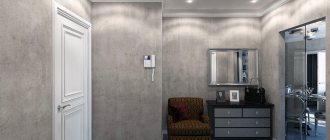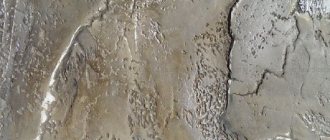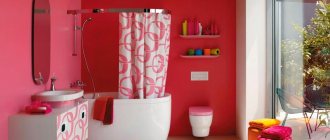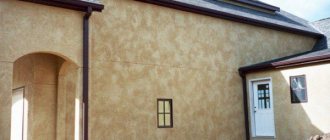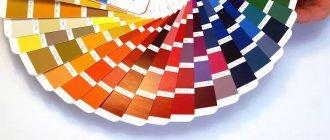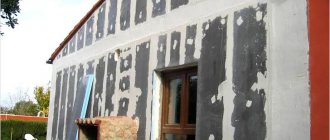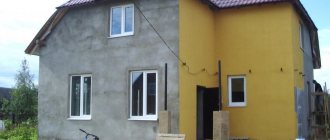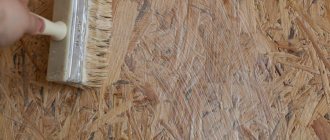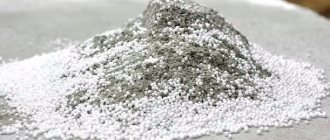The main requirement for facade plaster is resistance to weather conditions and protection of the building facade from bad weather. Therefore, the requirements for facade plaster are much higher than for plaster mixtures for interior decoration. What types of facade plaster there are in terms of composition and texture, with photos and examples, will be explained within the framework of this article.
Types of plaster for facades
Depending on the components, there are four types of compositions:
- mineral;
- acrylic;
- silicone;
- silicate.
Different types of plasters have different ductility, strength, vapor permeability, service life and other parameters.
Mineral
This type of plaster is characterized by the fact that the basis for it is cement. The mixture usually consists of cement, river or sea sand, and lime.
Manufacturers add plasticizers and modifying additives to the mixtures, accelerating setting, imparting frost resistance or corrosion resistance.
The positive qualities of mineral facade plasters are:
- mechanical strength and good adhesion to the building facade:
- combination of water-repellent properties with vapor permeability;
- resistance to temperature changes;
- relative cheapness.
Negative sides:
- is not subject to tinting, so to change the color you have to use facade paint after finishing the plastering work, the choice of colors is poor;
- without the addition of plasticizers, very low elasticity and tendency to cracking.
Gypsum plasters that have recently appeared on the market are afraid of prolonged direct contact with water, and due to the abundance of polymers in their composition, they do not allow steam to pass through and are not environmentally friendly.
Color and texture
Facade plaster not only protects the walls of the house, but also decorates them. With the help of such finishing, you can achieve an optimal combination of the facade with other elements of the building, select the desired color and texture.
Plaster for external walls is available in a wide range of colors. If you need to create a pronounced texture, use a mixture with the addition of stone chips or ceramic granules.
Also, the surface of the plastered layer is treated with special graters, changing the texture of the coating. This method creates popular patterns such as “bark beetle”, “lamb”, etc. More information about the technology of applying “bark beetle” plaster?
Which decorative plaster is best for the facade is decided individually in each case. Using it, you can create any patterns, even simulating brickwork and natural materials (wood, stone).
Acrylic
Acrylic-based facade plaster is used after leveling the walls with a mineral solution. It has good decorative properties, is elastic and has good mechanical strength. In addition to decorative properties, it also performs a protective function.
In addition to the pros, there are also cons:
- relative high cost of the material;
- acrylic can be flammable, although not very flammable;
- there is no ability to transmit steam, which makes it advisable to use acrylic plaster over foam or polystyrene foam insulation;
- the ability of acrylic to absorb dust, causing the surface of the facade to turn gray and lose its decorative properties after several years of use.
Variety of textures
The texture of the facade is solely an indicator of the decorative design of the building. This indicator does not determine the characteristics of the coating: strength, durability or moisture resistance.
Textures for the facade can be:
- old generation (texture depth no more than 5 mm);
- modern (requires the use of modern materials).
To apply plaster, devices are used that help create a textured pattern: textured rollers, graters, sponges and other tools.
The classification of textures is determined by three types:
In addition, the textured coating can be painted in any color or glazed to add brightness to the facade and additional decorativeness.
The texture of bark beetles is the most common type of design, which has several varieties:
- vertical;
- horizontal;
- circular;
- cross.
Bark beetle plaster contains special grains , which, when applied using a certain method, form a pattern similar to the passages of the bark beetle.
Mosaic plaster contains granules of stone chips of natural origin from one or more mineral rocks. Such inclusions ensure the durability of the coating and decorative design of the facade.
Silicone
Shows the best performance among all types of plasters. It has elasticity, strength, vapor permeability, and does not crack due to significant shrinkage of the walls. This property makes silicone plaster indispensable for facades of buildings made of foam concrete, which exhibit significant shrinkage during the first year of operation.
Despite its vapor permeability, it repels moisture well, does not absorb dust and does not lose its decorative properties for a long time. In coastal areas with an aggressive environment, silicone facade plaster is recommended to protect the building from its effects. Its disadvantage is its very high cost.
How to make it yourself
To get a lime mortar, you need to mix water and quartz sand. Sand is added gradually to obtain a medium liquid mixture. Lime plaster adheres very well to walls, but takes a very long time to dry. The lifespan of lime plaster is short. If you add cement to the composition, you will get a more damage-resistant mixture. To do this, you need to mix sand and cement, add lime, previously diluted with water. The whole mixture must be mixed well. Medium strength will be achieved within 16 hours.
The video explains how to make façade plaster for exterior use with your own hands:
Lime clay mortar is the cheapest. Lime is prepared in advance, then mixed with clay, then sand is added. The mixture must be applied to the walls within 3 hours. Plaster can be used either as a finishing material or as a decorative one. The main thing is to make the right choice.
Silicate
Silicate-based plaster is a decorative textured material intended for application in a thin layer.
It has good vapor permeability and is used with insulation materials like mineral wool, which also allow air to pass through. It has the ability to repel moisture and dust and retains its decorative properties for a long time. Does not lose its properties when washed.
Selection of plaster
In terms of mechanical strength and durability, the best choice is acrylic plaster due to its elasticity, but it must be periodically, once every three to four years, treated with façade paint, also acrylic-based. The service life of such plaster is from 15 to 25 years.
The next most durable are silicone and silicate compounds, with a service life of up to 20 years. Cement-based solutions, despite their strength, are not elastic and last no more than 10 years.
The best penetrating waterproofing for concrete - selection criteria, application rules, storage featuresReinforced concrete columns
- Penetrating waterproofing for concrete
Smooth surfaces are more prone to cracking than rough surfaces. On a rough surface, moreover, cracks and chips are much less noticeable.
The color of the plaster fades faster, the less resistant the pigment is to UV radiation. An important factor is the antistatic ability of the plaster, which characterizes its ability to absorb dust. What also plays a role is what gives color to the façade – pigment in the solution, or façade paint applied over a layer of plaster.
How to plaster external walls - technology for finishing work
When preparing to plaster the facade, carefully study the technology requirements. It provides for the following stages of work:
Carefully study the technology requirements when preparing to plaster the facade
- Choice of finishing material.
- Preparation of the external surface of the walls.
- Installation of guide elements.
- Applying the plaster mixture.
- Clean finishing.
Each stage has its own characteristics. Let's look at them in more detail.
Choosing material for plastering external walls
When choosing a suitable mixture for finishing work, pay attention to the following points:
- performance properties;
- shelf life of the plaster composition;
- manufacturer rating;
- reviews from professional builders;
- adhesion of the finishing mixture.
Also analyze the adhesive properties of the material and the need for additional preparation for application.
Preparing walls for applying finishing mortar
You should take responsibility for preparing the surface of façade walls. Their condition affects the quality of plastering activities.
The preparation of the surface of facade walls should be taken responsibly
Prepare the surface of the walls according to the following algorithm:
- Remove old plaster with a chisel and hammer or use a hammer drill.
- Clean the surface from finishing residues, sweep away dust, and remove grease and oil stains.
- Cut the brick joints by widening and deepening the joint areas.
- Remove the bumps, seal existing cracks and level out elevation differences with putty.
- Apply a deep penetration primer to the wall surface and wait until it dries.
- Attach a plaster mesh with square cells with a side of 20-25 mm to the outer surface.
If there are significant deviations in the flatness of the walls, there will be a need to apply an increased layer of plaster mixture. This leads to increased consumption of materials and increases the likelihood of plaster peeling in problem areas. Once you have completed your preparation, proceed to the next step.
Fixation of special beacons
Beacons are made of metal profiles and are securely fixed to the walls at certain intervals. Guides allow you to smooth out the plaster mixture using a rule, ensuring a flat finish.
To install beacons, you must perform a number of operations:
- Check the verticality of the walls by level or plumb.
- Cut the beacons to the height of the walls.
- Step back 20-30 cm from the edge and draw a vertical line.
- Apply a thick solution to the marking at intervals of 0.5-0.6 m.
- Place the guide along the markings and press into the solution.
- Adjust the verticality of the beacons according to the level.
- Remove any solution that has floated onto the surface of the guides.
- Fill the cavities under the beacon after the solution has set.
Fixing special beacons allows you to use a rule to smooth out the plaster mixture, ensuring a flat finish.
When determining the distance between the guides, take into account the length of the rule. The optimal interval between beacons is 1.5-1.8 m.
Applying external plaster to the facade of a house - finishing rules
Plastering technology involves sequential application of the material:
- First, a liquefied solution is poured. You should add polyvinyl acetate glue to it and add water until it reaches a creamy consistency.
- After drying, the main layer of plaster is applied. It is necessary to evenly distribute the finishing composition over the surface, ensuring a layer thickness of no more than 50 mm.
- Grouting completes the finishing activities. A wooden or foam trowel is used to smooth out uneven surfaces and seal cracks. Grouting should be done in a circular motion.
Start finishing after 5 days, when the plaster is completely dry.
How to properly plaster external surfaces - protecting problem areas
Problem areas include corner areas, as well as surfaces adjacent to window and door openings. Plaster problem areas using standard technology.
Paying attention to the following points:
- thoroughness of sealing defects on the surface;
- uniform filling of cavities with plaster mortar;
- flatness of the finishing composition after grouting.
Grouting must be done correctly. First, make spiral-shaped leveling movements and, starting with a small diameter, gradually move to a larger circle.
Exterior wall finishing - finishing operations
At the final stage of work, finishing is carried out. Possible options:
- creating decorative spray;
- painting the surface in the required color;
- formation of a rough surface.
The choice of the optimal finishing option is carried out individually.
